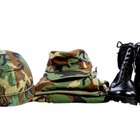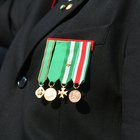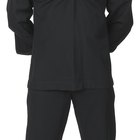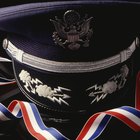
The uniform is the most visible outward sign of military service. Both practical and aesthetic, the uniform identifies a servicemember as part of a unit and serves as an outfit in the line of duty, or in ceremonial occasions. A uniform, by definition, is standardized. Without specifications, it wouldn't fulfill its purpose.
Solidarity
The specifications of military uniforms help reinforce the idea of individuals as belonging to a single unit in which each (within rank) is equal. Uniform specifications, by which each member must abide, emphasize regularity, cohesion, group cooperation and solidarity.
Symbolism
Military uniforms are practical, but they are also heavily symbolic. This is true of the regalia and insignia donned by members of all ranks, though particularly officers. The patches, medals, pins and buttons that represent military honors and achievements are worn according to standardized specifications. The consistency of such specifications gives meaning to the symbols and elevates their renown in the eyes of others. Such symbolism is not just ceremonial, but also practical. Rank insignia allows servicemembers' rank to be identified instantly, which has important implications for the functioning of a hierarchical organization such as the military.
Multi-functionality
Most branches of the military don't simply issue a single uniform to members. Rather, multiple uniforms are worn for multiple occasions. A soldier in the Army, for example, may wear a desert battle dress uniform, an army green service uniform, or a dress blue evening uniform. The specifications of each uniform pertain to the distinct requirements of each situation. Dress uniforms, such as the aforementioned blue or the formal dress white, are worn according to specifications that are designed to visually impress in formal or ceremonial events.
In the Line of Duty
Uniform specifications are designed to maintain the uniform's functionality in the line of duty. Uniforms that fail to conform to the set standards could interfere with a servicemember's ability to perform his duty. For example, a cold-weather uniform that's not actually adapted to the cold according to official specifications could pose a risk to that soldier's well-being in the field.
Related Articles

How to Design a Military Uniform

Military Dress Blues Setup Guide

Proper Placement of Medals on a USMC ...

What Are the Parts of a Military ...

How to Wear Marine Corps Ribbons & ...

Navy Pea Coat Uniform Regulations

Marine Dress Blues Regulations

How to Dress Your JROTC Uniform

How to Wear the USMC Dress Blues

The Army Regulations for a Female in ...

How to Iron a Uniform Shirt

History of Military Hats

What Are the Duties of a Church Trustee ...

The History of Pinstripe Suits

How to Iron a Marine Uniform

How to Put Rank on an ACU Cap

What Is the Meaning of Flag Day in the ...

What Is the Difference Between Air ...

How to Wear a Collar Brass Class A ...

Pennsylvania Grants for Adopted Children
References
Writer Bio
David Ferris started writing professionally in 2006 and has been published in several newspapers. He has worked in a variety of fields including education and law. He strives to one day be an authority on all subjects, great and small. Ferris has a Bachelor of Arts in political science.
Photo Credits
Jupiterimages/Comstock/Getty Images